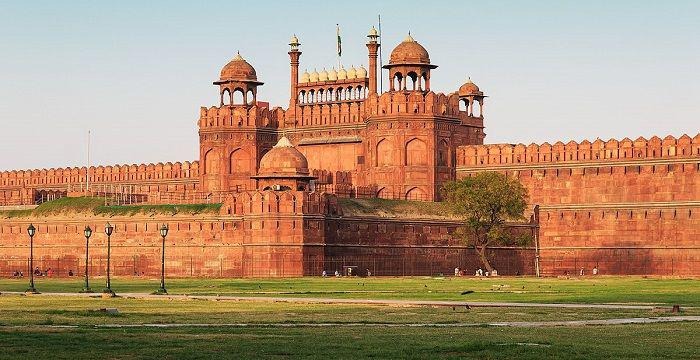
The Lahori Gate is the main entrance to the Red Fort in Delhi. The fort is approached through a covered street flanked by arcaded apartments called the Chhatta Chowk. Situated on the western wall of the fort, the gate received its name because it led to the city of Lahore, in Punjab, Pakistan.
The secondary entrance is the Delhi Gate. The gateway consists of three stories, each decorated with square, rectangular and cusped arched panels. These are flanked by semi-octagonal towers crowned by two open octagonal pavilions. The whole gate is clad in red sandstone, except the roofs of the pavilions, where white stone is used. Between the two pavilions is a screen of miniature chhatris having seven miniature marble domes. Continuing around the whole wall are flame-shaped battlements. The gate was provided with a 10.5 high metre barbican by Aurangzeb (1658-1707), with its entrance to the north. It is said that Shah Jahan, while under house arrest, wrote to Aurangzeb and criticized his decision: “You have made a fort a bride, and set a veil on it. Every year since Indian Independence Day in 1947, the national flag has been raised and the Prime Minister has made a speech from the ramparts at the gate. In the 1980s, the security of the area was increased by blocking the tower windows as a security measure against sniper attacks.

The Qutub Minar is a minaret that forms a part of the Qutab complex, a UNESCO World Heritage Site in the Mehrauli area of Delhi, India. Qutub Minar is a 73-metre (239.5 feet) tall tapering tower of five storeys, with a 14.3 metres (47 feet) base diameter, reducing to 2.7 metres (9 feet) at the peak. It contains a spiral staircase of 379 steps. Its design is thought to have been based on the Minaret of Jam, in western Afghanistan. Qutab Ud-Din-Aibak, founder of the Delhi Sultanate, started construction of the Qutub Minar’s first storey around 1192. In 1220, Aibak’s successor and son-in-law Iltutmish completed a further. Three storeys. In 1369, a lightning strike destroyed the top storey. Firoz Shah Tughlaq replaced the damaged storey, and added one more. Sher Shah suri also added an entrance to this tower while he was ruling and Humayun was at an exile. It derived its name from the Sufi saint Qutbuddin Bakhtiar Kaki whom Qutab Ud-Din-Aibak revered. The Minar is surrounded by several historically significant monuments of the Qutab complex, including Quwwat-ul-Islam Mosque, which was built at the same time as the Minar, and the much older Iron Pillar of Delhi. The nearby pillared Cupola known as “Smith’s Folly” is a remnant of the tower’s 19th century restoration, which included an ill-advised attempt to add a sixth storey.
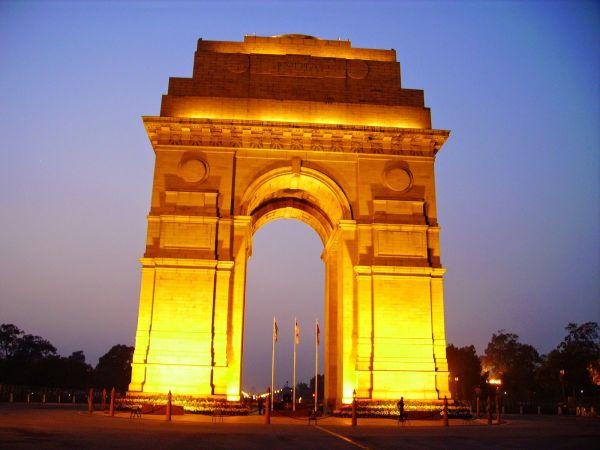
The India Gate (originally called the All India War Memorial) is a war memorial located astride the Rajpath, on the eastern edge of the”ceremonial axis” of New Delhi, India, formerly called Kingsway.
India Gate is a memorial to 70,000 soldiers of the Indian Army who died in the
period 1914–21 in the First World War, in France, Flanders, Mesopotamia,
Persia, East Africa, Gallipoli and elsewhere in the Near and the Far East, and the Third Anglo-Afghan War. 13,300 servicemen’s names, including some soldiers and officers from the United Kingdom, are inscribed on the gate. The India Gate, even though a war memorial, evokes the architectural style of the triumphal arch like the Arch of Constantine, outside the Colosseum in Rome, and is often compared to the Arc de Triomphe in Paris, and the Gateway of India in Mumbai. It was designed by Sir Edwin Lutyens. In 1971, following the Bangladesh Liberation war, a small simple structure, consisting of a black marble plinth, with a reversed rifle, capped by a war helmet, bounded by four eternal flames, was built beneath the soaring Memorial Archway. This structure, called Amar Jawan Jyoti, or the Flame of the Immortal Soldier, since 1971 has served as India’s Tomb of the Unknown Soldier. India Gate is counted among the largest war memorials in India.

The Masjid-i Jahān-Numā (World-reflecting Mosque), commonly known as the Jama Masjid of Delhi, is one of the largest mosques in India. It was built by Mughal emperor Shah Jahan between 1644 and 1656 at a cost of 1 million rupees, and was inaugurated by an imam from Bukhara, present-day Uzbekistan. The mosque was completed in 1656 AD with three great gates, four towers and two 40 m high minarets constructed of strips of red sandstone and white marble. The courtyard can accommodate more than 25,000 people. There are three domes on the terrace which are flanked by the two minarets. On the floor, a total of 899 black borders are marked for worshippers. The architectural plan of Badshahi Masjid, built by Shah Jahan’s son Aurangzeb at Lahore, Pakistan, is similar to the Jama Masjid, Delhi.
The mosque has been the site of two attacks, one in 2006 and another in 2010. During the first, two explosions occurred in the mosque, injuring thirteen people. In the second, two Taiwanese students were injured as two gunmen opened fire upon them.

The Lotus Temple, located in Delhi, India, is a Bahá’í House of Worship that was dedicated in December 1986, costing $10 million. Notable for its flowerlike shape, it has become a prominent attraction in the city. Like all Bahá’í Houses of Worship, the Lotus Temple is open to all, regardless of religion or any other qualification. The building is composed of 27 free-standing marble-clad “petals” arranged in clusters of three to form nine sides, with nine doors opening onto a central hall with a height of slightly over 40 metres and a capacity of 2,500 people. The Lotus Temple has won numerous architectural awards and has been featured in many newspaper and magazine articles. A 2001 CNN report referred to it as the most visited building in the world.

Humayun’s tomb (Maqbaera e Humayun) is the tomb of the Mughal Emperor Humayun in Delhi, India. The tomb wascommissioned by Humayun’s first wife and chief consort, Empress Bega Begum (also known as Haji Begum), in 1569-70, and designed by Mirak Mirza Ghiyas, a Persian architect chosen by her. It was the first garden-tomb on the Indian subcontinent and is located in Nizamuddin East, Delhi, India, close to the Dina-panah Citadel, also known as Purana Qila (Old Fort), that Humayun founded in 1533. It was also the first structure to use red sandstone at such a scale. The tomb was declared a UNESCO World Heritage Site in 1993, since then has undergone extensive restoration work, which is complete. Besides the main tomb enclosure of Humayun, several smaller monuments dot the pathway leading up to it, from the main entrance in the West, including one that even pre-dates the main tomb itself, by twenty years; it is the tomb complex of Isa Khan Niyazi, an Afghan noble in Sher Shah Suri’s court of the Suri dynasty, who fought against the Mughals, constructed in 1547 CE.
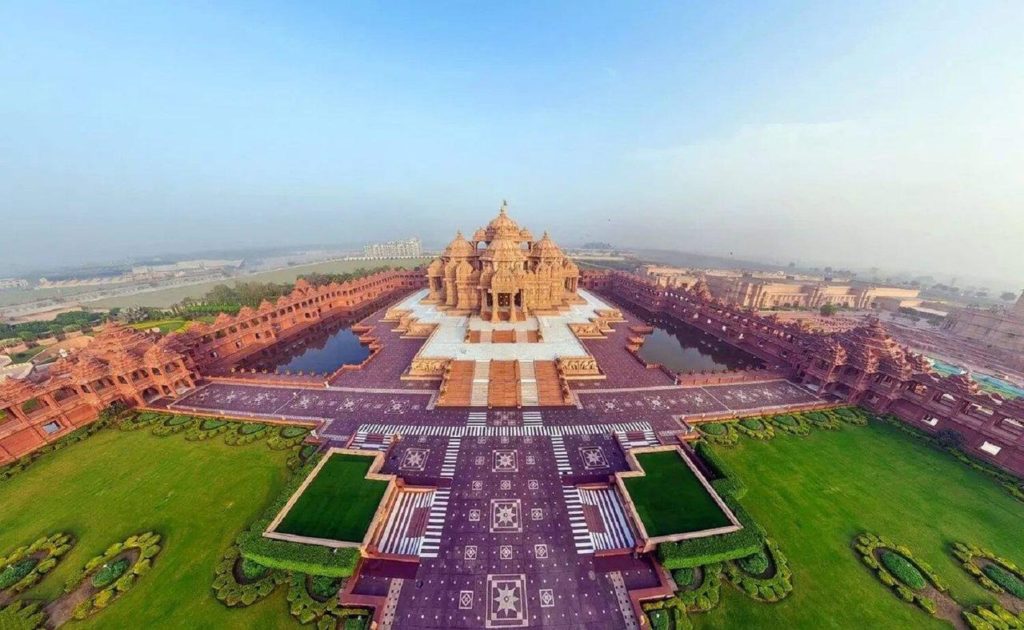
Akshardham or Swaminarayan Akshardham complex is a Hindu mandir and a spiritual-cultural campus in New Delhi, India. Also referred to as Akshardham Temple or Swaminarayan Akshardham, the complex displays millennia of traditional Hindu and Indian Culture, spirituality, and architecture. The temple, which attracts approximately 70 percent of all tourists who visit Delhi was officially opened on 6 November 2005 by Dr. A.P.J. Abdul Kalam. It sits near the banks of the Yamuna adjacent to the 2010 Commonwealth Games village in eastern New Delhi. The temple, at the centre of the complex, was built according to the Vastu shastra and Pancharatra shastra. The complex features an Abhisheka Mandap, Sahaj Anand water show, a thematic garden and three exhibitions namely Sahajanand Darshan (Hall of Values), Neelkanth Darshan (an IMAX film on the early life of Swaminarayan as the teenage yogi, Neelkanth) and Sanskruti Darshan (cultural boat ride). According to Swaminarayan Hinduism the word Akshardham means the abode of almighty Lord Swaminarayan and believed by followers as a temporal home of God on earth.
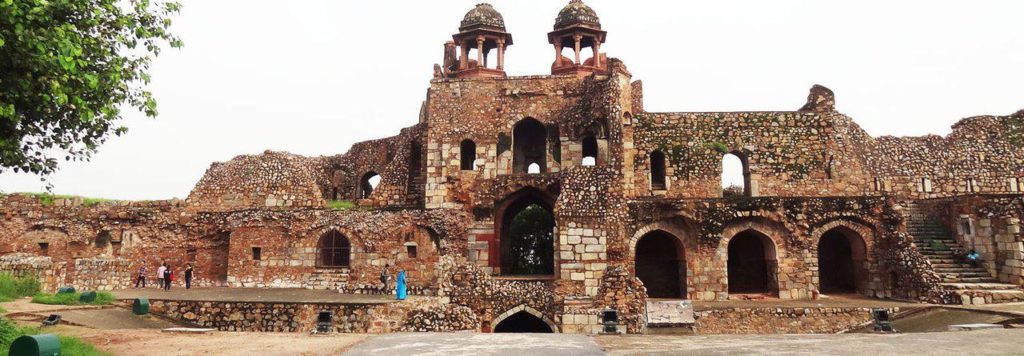
Purana Qila (Old Fort) is one of the oldest forts in Delhi. The present citadel at Purana Qila is believed to have been built under Sher Shah Suri. But according to ASI’s Vasant Swarnkar, the excavations — the last one was in 2013-14 — point to traces from the 3rd century BC, the pre-Mauryan period. The first two rounds of excavations — in 1954-55 and 1969-72 — by then ASI director, BB Lal, had unearthed traces of PGW under the mound. At the time, Lal had embarked on a mission to excavate various sites mentioned in the Mahabharata text and claimed to have found such traces as a common feature at all those sites. On the basis of PGW, which archaeologically belongs to the 6th-12th century BC, Lal had claimed that Purana Qila is the Pandava kingdom of Indraprastha, estimating 900 BCE as the period of the war recounted in the epic. Excavations carried out by Archaeological Survey of India (ASI) at Purana Quila in 1954-55 (trial trenches) and again 1969-1973 by its Director, B B Lal, have unearthed Painted Grey Ware dating to 1000 BCE. The fort was the inner citadel of the city of Din Panah during Humayun’s rule who renovated it in 1533 and completed five years later. The founder of the Suri Dynasty, Sher Shah Suri, defeated Humayun in 1540, naming the fort Shergarh, he added several more structures in the complex during his five-year reign. Purana Qila and its environs flourished as the “sixth city of Delhi. When Edwin Lutyens designed the new capital of British India, New Delhi, in the 1920s, he aligned the central vista, now Rajpath, with Purana Qila. During the Partition of India, in August 1947 the Purana Qila along with the neighbouring Humayun’s Tomb became the site for refuge camps for Muslims migrating to newly founded Pakistan. This included over 12,000 government employees who had opted for service in Pakistan, and between 150,000–200,000 Muslim refugees, who swarmed inside Purana Qila by September 1947, when Indian government took over the management of the two camps. The Purana Qila camp remained functional till early 1948, as the trains to Pakistan waited till October 1947 to start. In the 1970s, the ramparts of Purana Qila were first used as a backdrop for theatre, when three productions of the National School of Drama were staged here: Tughlaq, Andha Yug and Sultan Razia, directed by Ebrahim Alkazi. In later decades it has been the venue of various important theatre productions, cultural events, and concerts. Today, it is the venue of a daily sound and light presentation after sunset, on the history of the “Seven Cities of Delhi”, from Indraprastha through New Delhi.
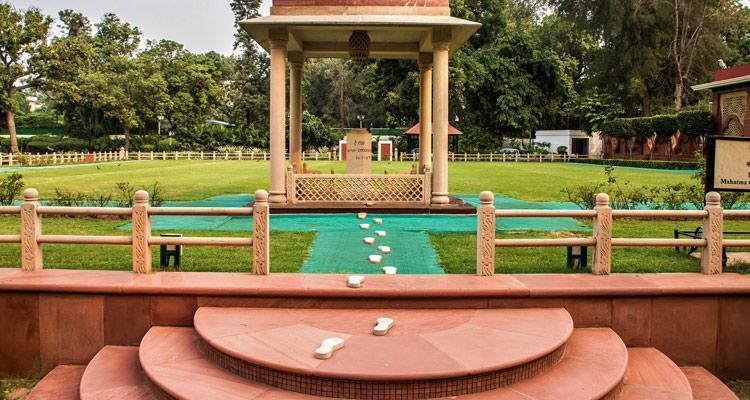
Gandhi Smriti formerly known as Birla House or Birla Bhavan, is a museum dedicated to Mahatma Gandhi, situated on Tees January Road, formerly Albuquerque Road, in New Delhi, India. It is the location where Mahatma Gandhi spent the last 144 days of his life and was assassinated on 30 January 1948. It was originally the house of the Indian business tycoons, the Birla family. It is now also home to the Eternal Gandhi Multimedia Museum, which was established in 2005.The 12-bedroom house was built in 1928 by Ghanshyamdas Birla. Sardar Patel and Mahatma Gandhi were frequent guests of the Birlas. During his final stay, Mahatma Gandhi stayed here from 9 September 1947 to 30 January 1948 when he was assassinated. Jawaharlal Nehru wrote to Ghanshyamdas Birla seeking to turn part of the Birla House in to a memorial. Ghanshyamdas was rather reluctant to give up the house with associated memories. The Birla House was purchased from KK Birla, in 1971, by the Government of India, after protracted and tough negotiations, in which, according to some reports, he even included the cost of fruit trees in the sale price. Eventually KK Birla, sold the property to the Government for Rs 5.4 million and seven acres of urban land in exchange, which was considered a very profitable deal. Birla House opened for the public on 15 August 1973, renamed the Gandhi Smriti (or Gandhi Remembrance). The museum in the building houses a number of articles associated with Gandhi’s life and death. Visitors can tour the building and grounds, viewing the preserved room where Gandhi lived and the place on the grounds where he was shot while holding his nightly public walk. Gandhi was shot during his prayers at the place where Martyr’s Column now stands.

Gurudwara Bangla Sahib is one of the most prominent Sikh gurdwara, or Sikh house of worship, in Delhi, India and known for its association with the eighth Sikh Guru, Guru Har Krishan, as well as the pool inside its complex, known as the “Sarovar.” It ranked No 1 among the best tourist and pilgrimage spot in Delhi (SURVEY-2017).It was first built as a small shrine by Sikh General Sardar Bhagel Singh in 1783, who supervised the construction of nine Sikh shrines in Delhi in the same year, during the reign of Mughal Emperor, Shah Alam II. It is situated near Connaught Place, New Delhi on Baba Kharak Singh Marg and it is instantly recognisable by its golden dome and tall flagpole, Nishan Sahib. Located next to it is the Sacred Heart Cathedral.



